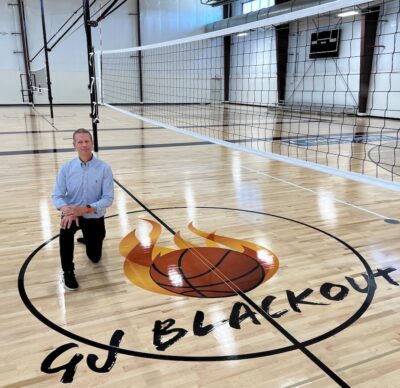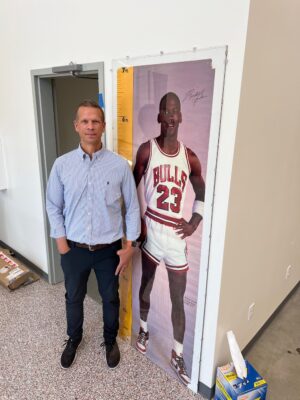BY TIM HARTY

Blackout Sports Fieldhouse opens for use by GJ Blackout basketball and Mesa Juniors volleyball
Until recently a sign on the property at 715 23 1/2 Road, where the 39,353-square-foot Blackout Sports Fieldhouse now stands, heralded its arrival with: “Coming in 2023.”
Oops!
Dean Havlik mentioned that sign during a June 18 interview when he acknowledged a targeted opening date of July 9 wasn’t going to happen, and July 29 became the new target. It didn’t open then, either.
Havlik, president of the nonprofit GJ Blackout basketball club’s board of directors, saw the humor in the sign that was two years premature. It deserved a “5” painted over the 3 by a civic-minded vandal.
Now, as August draws to a close, Havlik confidently said on Thursday, Aug. 21, “We’ll have kids playing on the courts this weekend.”
The fieldhouse finally is ready for basketball and volleyball players – the Mesa Juniors Volleyball Club partnered in the project – to take to its courts. Then, in a couple weeks, Sept. 13 to be exact – dare we say that? – the grand opening will be celebrated.
“It’s very exciting,” Havlik said. “It’s pretty much a dream come true. … We originally talked about doing only one court, and then it’s expanded to this monster of four courts. And to see it like this …”
Havlik was referring to how beautiful the inside of the building now is. No more exposed beams. No more unpainted drywall. No more gray concrete floors. Instead, basketball hoops and volleyball nets are up, three-tier bleachers are situated at the short ends of the four basketball courts, which also serve as six volleyball courts or 12 pickleball courts, and the wood-floor courts are waxed and shining brilliantly.
“North Peak has done an amazing job with what they’ve constructed here,” Havlik said of the fieldhouse’s builder, general contractor North Peak Construction. “They deserve a lot of credit.”
Havlik added the finished product has been a long time coming.
And that sign that suggested the sports complex would be coming in 2023? He said it was taken down, and, “I’ve got to figure out where that sign is, actually, because I want it.”
The Final Cost

As gratifying as it will be for so many GJ Blackout and Mesa Juniors athletes to finally grace their new home, Havlik has another date he’d like to see arrive sooner rather than later. That’s the day the fieldhouse project is fully funded, as in approximately $8.3 million. Havlik estimates the building is going to be about $7.3 million, and the 10 acres it sits on cost about $1 million.
That’s a pretty penny more than GJ Blackout intended when it entered the project, as Havlik said, “We started off wanting to keep it under $5 million. It just hasn’t quite worked out. There just keeps being something else we want to add to it.”
When he spoke June 18 about the remaining balance, the amount that hasn’t been covered yet by grants and donations, Havlik said about $1 million still needed to be raised.
On Aug. 21, when he addressed the subject, Havlik said about $400,000 remained after the project received a recent grant of $75,000 from the Sessions Family Foundation.
Earlier in the capital campaign, the Daniels Fund donated $300,000. Community Hospital donated $100,000. The Grand Junction Lions Club gave $25,000.
El Pomar, the Adolph Coors Foundation and The Boettcher Foundation made donations. And many, many others made smaller donations, which add up.
Havlik said GJ Blackout’s grant writer, Jenny Aubert, has been “awesome.”
And her job won’t end with the grant that completes the funding for the fieldhouse. Havlik said they will continue to seek grants and donations in hopes it will allow GJ Blackout to keep its fees low for its league teams and club teams.
“We are a nonprofit, and we want to stay that way,” he said, but some fee increases may be needed, as he added, “We’re definitely not in this for a profit, that’s for sure, but we do want to cover our costs. That’s important that we keep this thing open.”
And it’s also GJ Blackout’s goal to avoid taking out a loan.
“We haven’t actually had to borrow money yet,” Havlik said. “We’re hoping it’s not necessary to take out any loans.”
Avoiding loans goes back to keeping costs low for GJ Blackout’s families.
“If we get a loan, that’s going to probably increase our cost a bit and our fees a bit, and we don’t want to do that,” he said.

Where It All Started
For GJ Blackout to be where it is now was unfathomable when Havlik founded it in 2011. The nonprofit club was formed for one team, an eighth-grade girls basketball team that Havlik’s daughter played for.
“Basically I noticed there wasn’t a good, kind of club type of atmosphere for basketball, for these more talented kids to play on,” he said.
As someone who played basketball throughout his youth in Phoenix, Ariz., Havlik knew the value of playing against better competition in big cities. He wanted the same for GJ Blackout, getting experience against competitive teams from the likes of Denver and Salt Lake City.
“So I started this team,” he said, “and then it went well that first year, and it kind of just took off from there.”
Indeed, it took off.
He couldn’t recall if it was 2016 or 2017, but one of those years brought boys basketball teams into the GJ Blackout fold.
And the initial concentration on fifth-graders to eighth graders eventually became third grade to eighth grade, and then some teams with high schoolers were formed.
Now, with the new facility, GJ Blackout will look to expand.
“We’re going to start with first grade,” Havlik said, “and then do more activities with high-schoolers.”
That expansion wasn’t possible until now, because there are only so many middle-school gyms in the Grand Valley. Havlik said School District 51 “has been really kind to us, letting us use their facilities.”
But limited courts and limited time slots were unavoidable, and lack of gym time became a motivator for GJ Blackout, which wanted to expand.
So, the idea of GJ Blackout’s own building took root.
“I’ve always wanted to have a facility like this,” Havlik said of Blackout Sports Fieldhouse, “but probably in the COVID years is when we started getting really serious about building the facility. Probably because we had more money in our hands to think about it.”
Being able to do it took the brains and brawn of a lot of people, and Havlik commended his colleagues on the GJ Blackout Board of Directors, saying, “We have a great board. … They’ve been extremely helpful with making decisions and things like that.”
He also expressed gratitude for the local businesses that made the fieldhouse possible, name-dropping the architect, Kraai Design Architecture, and the engineers from Bighorn Engineering and Austin Civil Group.
“Everything’s local, local architects, local engineers that have been involved with this, so that was important to us,” Havlik said.
And when the time finally came in the spring of 2024, North Peak Construction broke ground and started building.
Growing The Ranks

When Havlik talks about expanding the teams and clubs and leagues because of the new fieldhouse, he’s talking about serious expansion and not just for GJ Blackout. He detailed it like this:
“We have our own leagues and system for GJ Blackout, and we’re going to continue that and expand that. So, take all the kids that play with us now, and then we’re going to expand that and get more kids.
“And then with the volleyball club that we’re partnering with, Mesa Juniors, they have their own club and things and their kids, and they’re going to expand their program because of this new facility.
“And then we’re going to be doing additional leagues that anyone can join, like new kids and things, and then we’ll also rent out any open spots to anyone else that wants to to use it.”
What that means in terms of the total number of kids from expanded teams and expanded leagues is a much bigger number than the approximately 600 kids GJ Blackout currently has.
“We want to try to get at least 5,000 kids in there, when you’re including all the volleyball and then all the other activities that we’re going to be doing,” Havlik said. “Right now, it’s hundreds, and we’re hoping to expand it to a few thousand.”
Physical Room To Grow
The completion of Blackout Sports Fieldhouse may not be the last of the construction, as Havlik said the building used about two acres of the property, leaving eight more for future use.
One thing Havlik believes has a great chance of coming to fruition is the allocation of some ground for beach volleyball.
“We’re not 100 percent sure we’re going to do this yet, but probably 90 percent sure we’re going to put some beach volleyball courts out on the north side of the building,” he said. “Pretty sure we’re gonna do that, but we haven’t actually pulled the trigger on that. … If we do the beach volleyball courts, it will probably be right after we open.”
Other discussions have involved a baseball field or a soccer field.
“The building’s situated right in front, and then all the back acreage is for expansion,” Havlik said. “We’ve talked about a lot of stuff. We could build another building behind there.”
All of that is “probably no time soon,” Havlik acknowledged, “but maybe some day. We have plenty of acreage to do that.”
When the time comes, maybe GJ Blackout will put out another sign to let everyone know when to expect it.
DONATIONS STILL NEEDED
The GJ Blackout basketball club needs about $400,000 yet to completely fund Blackout Sports Fieldhouse. To donate, go online to: gjblackout.com/become-a-partner
To learn more about the fieldhouse, go to: blackoutfieldhouse.com.

